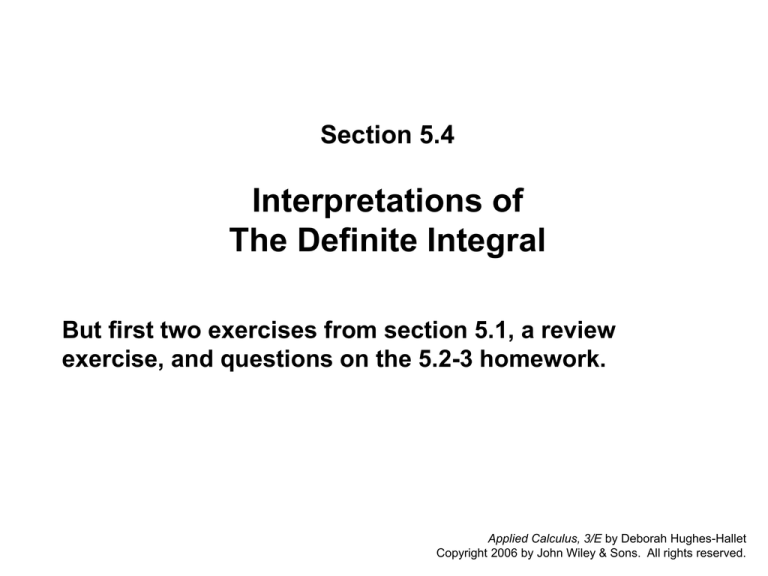
Section 5.4
Interpretations of
The Definite Integral
But first two exercises from section 5.1, a review
exercise, and questions on the 5.2-3 homework.
Applied Calculus, 3/E by Deborah Hughes-Hallet
Copyright 2006 by John Wiley & Sons. All rights reserved.
Exercise 5.1 #14
The figure shows the rate of change of a fish
population. Estimate the total change in the
population.
Lower sum = 10 + 21 + 10 × 4 = 164
Upper sum = 21 + 22 + 21 × 4 = 256
Left sum = 10 + 21 + 21 × 4 = 208
Right sum = 21 + 21 + 10 × 4 = 208
Either the average of the lower and upper sums, 210 fish, or the average of the left
and right sums, 208 fish, provides a good estimate for the total change in the fish
population.
Exercise 5.1 #20
A car speeds up at a constant rate from 10 to 70 mph over a period of half an hour. Its fuel
efficiency (in miles per gallon) increases with speed; values are in the table. Make lower and
upper estimates of the quantity of fuel used during the half hour.
Speed (mph)
Fuel efficiency (mpg)
miles/hr
×
miles/gal
10
15
20
18
30
21
40
23
50
24
60
25
hr = gal
Extremely Low =
10 1
26 2
≈ 0.19 gal
Extremely High =
10 20 30 40 50 60 1
+ + + + +
18 21 23 24 25 26 12
≈ 0.73 gal
Very Low
=
Low
=
15 25 35 45 55 65 1
+ + + + +
18 21 23 24 25 26 12
≈ 0.84 gal
High
=
15 25 35 45 55 65 1
+ + + + +
15 18 21 23 24 25 12
≈ 0.91 gal
Very High
=
20 30 40 50 60 70 1
+ + + + +
15 18 21 23 24 25 12
≈ 1.03 gal
70 1
15 2
≈ 2.33 gal
70
26
Temperature Example
Suppose 𝑓(𝑡) is the outdoor temperature in °C at 𝑡 hours after midnight. The table
provides known values of 𝑓.
0
3
8
5
10
7
12
10
18
2
24
-6
1. Estimate 𝑓′(10) and provide an interpretation.
10−5
12−8
= 1.25 °C/hr is the rate at which the temperature is changing at 10:00am.
2. Estimate 𝑓′′(10) and provide an interpretation.
1.5−1
11−9
= 0.25 °C/hr2 is the acceleration of the temperature at 10:00am.
3. Estimate the average temperature during the 24-hour day.
(4 × 8 + 2 × 6 + 8.5 × 2 + 6 × 6 − 4 × 6)/24 ≈ 3.0 °C
4. Estimate the area between the graph of 𝑦 = 𝑓(𝑡) and the 𝑡-axis.
4 × 8 + 2 × 6 + 8.5 × 2 + 6 × 6 + 1 × 2 + 3 × 4 ≈ 111 °C-hr
Meaning of the Integral
Applied Calculus, 3/E by Deborah Hughes-Hallet
Copyright 2006 by John Wiley & Sons. All rights reserved.
Heart Example
Suppose r(t) is the rate at which the heart is pumping blood in liters per second and t
is the time in seconds.
What does the following mean?
10
r t dt
0
The amount of blood in liters pumped by the heart over the first ten seconds.
Applied Calculus, 3/E by Deborah Hughes-Hallet
Copyright 2006 by John Wiley & Sons. All rights reserved.
Feet Example
If the units for 𝑓(𝑥) are feet per minute and the units of 𝑥 are feet, then what are the
units of the following.
5
f x dx
0
Feet squared per minute.
What might 𝑓(𝑥) and the integral represent?
𝑓(𝑥) could represent the rate at which the sides of a square are changing when the
side has length 𝑥.
The integral could represent the rate at which some area has changed as some length
has gone from 0 to 5 feet.
Applied Calculus, 3/E by Deborah Hughes-Hallet
Copyright 2006 by John Wiley & Sons. All rights reserved.
Population Example
Suppose 𝑓(𝑡) is the rate of change of the population of a city, in people per year, at time 𝑡 years
since the start of 1990. If the population of the city is 5000 people at the start of 1990, give an
expression for the population today.
13.88
5000 +
𝑓 𝑡 𝑑𝑡
0
If 𝑓 𝑡 = 60 𝑡, then what is the population today?
The Mathematica command
5000 + Integrate[60 Sqrt[𝑡 , 𝑡, 0,13.88
yields 7068.
Applied Calculus, 3/E by Deborah Hughes-Hallet
Copyright 2006 by John Wiley & Sons. All rights reserved.
Flu Example
In Figure 5.11, the function f (t) gives the rate at which healthy people become sick with the flu, and
g(t) is the rate at which they recover. Which of the graphs (a) – (d) could represent the number of
people sick with the flu during a 30-day period?
For t < 12, we have f (t) > g(t), so the
number of sick people is increasing.
For t > 12, we have f (t) < g(t), so the
number of sick people is decreasing.
Since the area between the curves is
greater for t > 12 than the area
between the curves for t < 12, the
decrease is larger than the increase.
The answer is (b).
Applied Calculus, 3/E by Deborah Hughes-Hallet
Copyright 2006 by John Wiley & Sons. All rights reserved.

![Partial derivatives [9.3]](http://s3.studylib.net/store/data/009572016_1-92c0e9c22c1deb5ae72568562d485794-300x300.png)
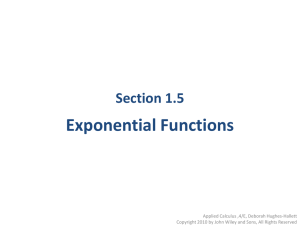
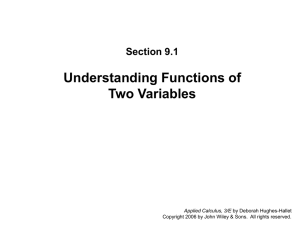
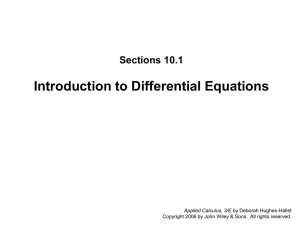
![Global max/min [4.3]](http://s2.studylib.net/store/data/005700750_1-6d8aea91972157c1c45aa1008072a9fe-300x300.png)
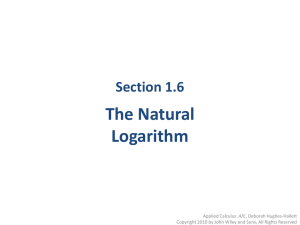
![Local max/min [4.1]](http://s2.studylib.net/store/data/005703785_1-fddedba53a949b6dd73bfcae3f9e6954-300x300.png)
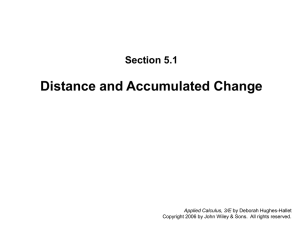

![Inflection points [4.2]](http://s2.studylib.net/store/data/005711558_1-7e6caa30b78ed23b978b40c18112cd02-300x300.png)

